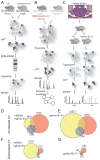Eph/ephrin signaling: genetic, phosphoproteomic, and transcriptomic approaches
- PMID: 22040918
- PMCID: PMC3288612
- DOI: 10.1016/j.semcdb.2011.10.018
Eph/ephrin signaling: genetic, phosphoproteomic, and transcriptomic approaches
Abstract
The Eph receptor tyrosine kinases and their ephrin partners compose a large and complex family of signaling molecules involved in a wide variety of processes in development, homeostasis, and disease. The complexity inherent to Eph/ephrin signaling derives from several characteristics of the family. First, the large size and functional redundancy/compensation by family members presents a challenge in defining their in vivo roles. Second, the capacity for bidirectional signaling doubles the potential complexity, since every member has the ability to act both as a ligand and a receptor. Third, Ephs and ephrins can utilize a wide array of signal transduction pathways with a tremendous diversity of cell biological effect. The daunting complexity of Eph/ephrin signaling has increasingly prompted investigators to resort to multiple technological approaches to gain mechanistic insight. Here we review recent progress in the use of advanced mouse genetics in combination with proteomic and transcriptomic approaches to gain a more complete understanding of signaling mechanism in vivo. Integrating insights from such disparate approaches provides advantages in continuing to advance our understanding of how this multifarious group of signaling molecules functions in a diverse array of biological contexts.
Copyright © 2011 Elsevier Ltd. All rights reserved.
Figures


Similar articles
-
Eph/ephrin signaling in epithelial development and homeostasis.Int J Biochem Cell Biol. 2009 Apr;41(4):762-70. doi: 10.1016/j.biocel.2008.07.019. Epub 2008 Aug 9. Int J Biochem Cell Biol. 2009. PMID: 18761422 Free PMC article. Review.
-
The Evolutionary History of Ephs and Ephrins: Toward Multicellular Organisms.Mol Biol Evol. 2020 Feb 1;37(2):379-394. doi: 10.1093/molbev/msz222. Mol Biol Evol. 2020. PMID: 31589243 Free PMC article.
-
Getting direction(s): The Eph/ephrin signaling system in cell positioning.Dev Biol. 2019 Mar 1;447(1):42-57. doi: 10.1016/j.ydbio.2018.01.012. Epub 2018 Jan 31. Dev Biol. 2019. PMID: 29360434 Free PMC article. Review.
-
Regulation and misregulation of Eph/ephrin expression.Cell Adh Migr. 2012 Mar-Apr;6(2):131-7. doi: 10.4161/cam.19690. Epub 2012 Mar 1. Cell Adh Migr. 2012. PMID: 22568953 Free PMC article. Review.
-
Ephs and ephrins during early stages of chick embryogenesis.Dev Dyn. 2003 Sep;228(1):128-42. doi: 10.1002/dvdy.10354. Dev Dyn. 2003. PMID: 12950087
Cited by
-
Ephrin-A2 and ephrin-A5 guide contralateral targeting but not topographic mapping of ventral cochlear nucleus axons.Neural Dev. 2015 Dec 15;10:27. doi: 10.1186/s13064-015-0054-6. Neural Dev. 2015. PMID: 26666565 Free PMC article.
-
Axon guidance in the auditory system: multiple functions of Eph receptors.Neuroscience. 2014 Sep 26;277:152-62. doi: 10.1016/j.neuroscience.2014.06.068. Epub 2014 Jul 7. Neuroscience. 2014. PMID: 25010398 Free PMC article. Review.
-
Aberrant cell segregation in the craniofacial primordium and the emergence of facial dysmorphology in craniofrontonasal syndrome.PLoS Genet. 2020 Feb 24;16(2):e1008300. doi: 10.1371/journal.pgen.1008300. eCollection 2020 Feb. PLoS Genet. 2020. PMID: 32092051 Free PMC article.
-
Inverse Expression Levels of EphrinA3 and EphrinA5 Contribute to Dopaminergic Differentiation of Human SH-SY5Y Cells.J Mol Neurosci. 2016 Aug;59(4):483-92. doi: 10.1007/s12031-016-0759-y. Epub 2016 May 23. J Mol Neurosci. 2016. PMID: 27217159
-
Altered genome-wide hippocampal gene expression profiles following early life lead exposure and their potential for reversal by environmental enrichment.Sci Rep. 2022 Jul 25;12(1):11937. doi: 10.1038/s41598-022-15861-9. Sci Rep. 2022. PMID: 35879375 Free PMC article.
References
-
- Henkemeyer M, Orioli D, Henderson JT, Saxton TM, Roder J, Pawson T, et al. Nuk controls pathfinding of commissural axons in the mammalian central nervous system. Cell. 1996;86:35–46. - PubMed
-
- Davy A, Soriano P. Ephrin signaling in vivo: look both ways. Dev Dyn. 2005;232:1–10. - PubMed
-
- Risley M, Garrod D, Henkemeyer M, McLean W. EphB2 and EphB3 forward signalling are required for palate development. Mech Dev. 2009;126:230–9. - PubMed
Publication types
MeSH terms
Substances
Grants and funding
LinkOut - more resources
Full Text Sources
Miscellaneous

